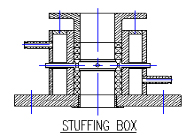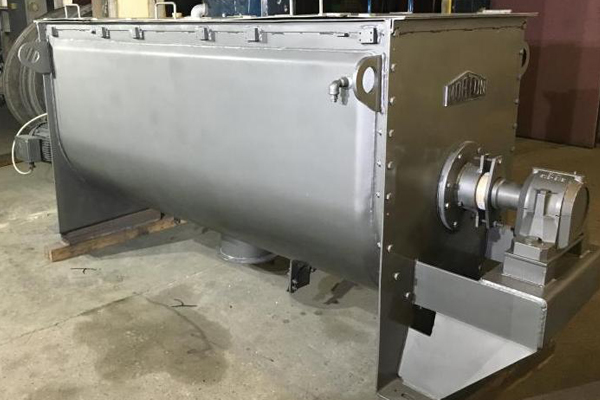WORKING
A ribbon blender consists of a U-shaped horizontal trough containing a double helical ribbon agitator that rotates within. The agitator’s shaft is positioned in the centre of the trough and has welded spokes on which the helical ribbons (also known as spirals) are welded. Since the ribbon agitator consists of a set of inner and outer helical ribbons, it is referred to as a “double” helical ribbon agitator. The gap between the ribbon’s outer edge and the internal wall of the container ranges from 3 to 6 mm depending on the application.
The ribbon agitator is powered by a drive system comprised of a motor, gearbox, and couplings. Ribbon blenders are generally powered by 10 HP motor for 1750 kg of product mass to be blended. The specific power may range from 3 to 12 kW/m3 depending on the products to be blended.
The agitator shaft exits the blender container at either end through the end plates bolted or welded to the container. The area where the shaft exits the container is provided with a sealing arrangement to ensure that material does not travel from the container to the outside and vice-versa. The blender assembly along with the drive system components viz. motor, gearbox, couplings and bearing supports is mounted on a supporting frame.
CONSTRUCTION
All products contact part in S.S. 316 quality and non-contact part in S.S. 304 quality & Mild Steel quality.
Consisting of ‘U’ shaped through of suitable dimensions with two side plates.
M.O.C. of Shell of S.S. 316 Quality.
Charging can be done from the top, through a hingeable lid (1/3 hinged 2/3 fixed) hopper or nozzle can be provided for additional spraying of additives.
By bottom discharge slide, iris or butterfly valve of suitable diameter, for regulated discharge.
Ribbon arms welded to the main shaft and ribbon blades of dual pitch interrupted type PTEF gland mechanism provided at shaft ends prevents ingress of external powder into the trough and prevents leakage.
Top dust preventing lid will be provided from S.S. 304 quality sheet.
The Unit will be driven by suitable HP TEFC 1440 RPM ISI standard electric motor, 415-440 volts, AC supply, 3 Phase, with a suitable reduction gearbox and V-belt pulleys to obtain final rpm of the blade. Mounted on suitable Mild Steel stand with protective covers for belt and coupling.The shell will be rested on fabricated stand from Mild Steel structural material.
SEAL
Our company provides various sealing devices according to difference of materials. The normal sealing structure is stuff seal and also called TEFLON seal. After using for a period, user(s) should fasten and enhance it. However, the dynamic seal has a long-time sealing effect and is especially fit for the powder, liquid.
OVERHANG OF SHAFT AND LOWER FIXED BEARING
The shaft is supported at the top end by bearing housing assembly. The lateral movement of impeller at the bottom of the shaft, tries to bend the shaft, if shaft is long (more than 3 meters). To avoid this a bottom bearing is provided. It is a non-rotating bearing, made of a sleeve of softer metal or plastic material.

Stuffing Box : This has two shells. The diameter of inner shell is larger than diameter of shaft. 3 or 4 packing rings are installed in this gap at bottom, followed by latern ring on top and 3 or 4 packing rings on top. Packing rings act as sealant while latern ring provides lubrication to shaft. The top rings are pressed from top by a ring. Cooling water flows in outer shell, which keeps the packing rings and lantern ring cool. It fits diectly on top of closed vessel inside the stool
DISCHARGING
After blending, the material is discharged from a discharge valve located at the bottom of the trough. The discharge can be fitted with any of various valves, viz. slide-gate, butterfly, flush bottom, spherical and other types depending on the application. The operation of the valves can be manual or pneumatically actuated. Ribbon blenders can be designed for multiple discharge ports. Unlike tumbling blenders where 100% discharge of material is achieved by gravity, in a ribbon blender the material is discharged by rotation of the ribbon agitator. It is practically difficult to achieve 100% discharge in the ribbon blender. Also, higher clearances between the external periphery of the outer ribbon and the container can result in unmixed spots at the trough bottom and can lead to discharge problems.
MIXING
The primary function is to mix dry powders and granules, creating a homogeneous blend.
HOMOGENIZATION
Ribbon blenders ensure a uniform distribution of ingredients, preventing segregation and ensuring consistent quality.
VERSATILE APPLICATIONS
They are used in various industries, including food processing, pharmaceuticals, chemicals, cosmetics, and more.
GENTLE MIXING
The ribbon design promotes gentle blending, minimizing material degradation or damage.
CONVECTIVE ACTION
The ribbons create a back-and-forth folding motion, ensuring a thorough and efficient mixing process.
CUSTOMIZABLE DESIGN
Ribbon blenders can be customized with features like jacketed vessels for heating/cooling, powder discharge systems, and more.
EFFICIENT MIXING
The design minimizes dead spots and ensures rapid product discharge.
EAZY CLEANING
Many ribbon blenders are designed with easy access and cleaning features.
ADVANTAGE
Efficient Mixing :
» Ribbon blenders use ribbon-shaped agitators to gently move and mix materials, ensuring thorough blending without damaging delicate products.
» They can be used to mix various dry powders, granules, pellets, and other solids.
High Capacity and Speed :
» Ribbon blenders are designed for high-capacity batch mixing, making them suitable for large-scale operations.
» They offer fast mixing speeds, reducing material retention time and minimizing the risk of deterioration.
Versatility and Customization :
» Ribbon blenders can be customized to meet specific industry and application requirements.
» They are used in various industries, including food and beverage, pharmaceuticals, chemicals, and more.
Ease of Cleaning and Maintenance :
» Ribbon blenders have a simple design with few components, making them easy to clean and maintain.
» They can be disassembled and cleaned conveniently, ensuring hygiene.
Other Notable Features :
» Some models offer features like double ribbons for even more thorough mixing, explosion-resistant construction for hazardous materials, and temperature control options.
» Automation options are also available for streamlined processing.
